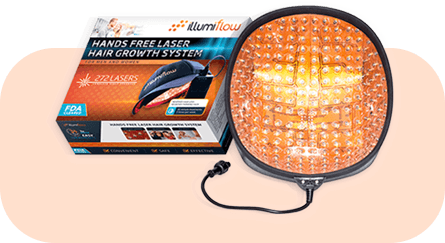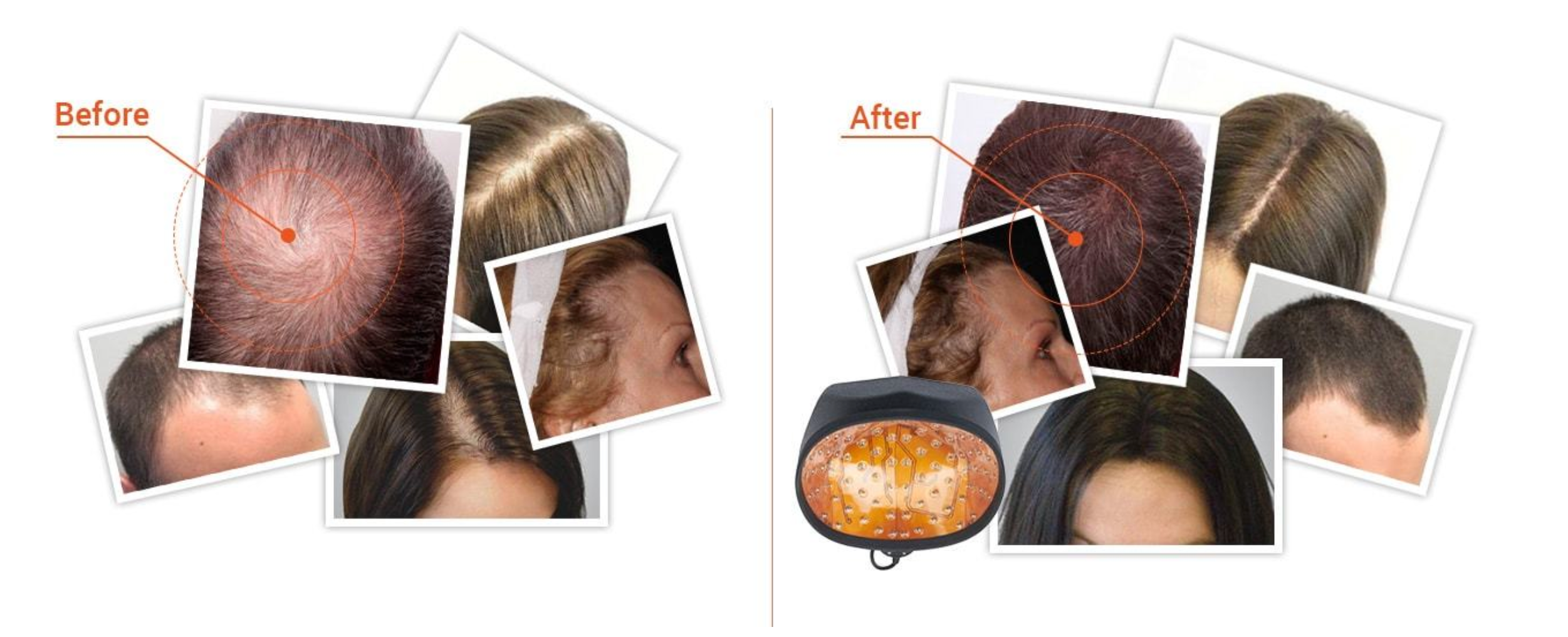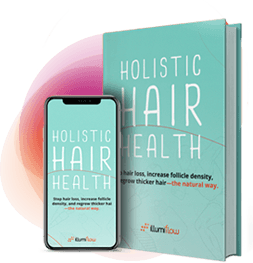Low Level Laser Therapy for Hair Loss: How Long Before You See Results

We can all agree that nobody wants to have to wait a long time for their hair to grow back.
But just how long does,or should, one have to wait?
Well, it turns out that you may not have to wait very long at all.
What if you learned that you could reverse hair loss and witness new hair growth in as little as a few months.
Keep reading to learn how you can reverse hair loss with low-level laser therapy (LLLT) and how soon you can expect to see results.
Hair Follicles and the Hair Growth Cycle
The typical growth of healthy hair progresses incrementally in phases over the course of several years.
Hair grows from the follicle, or root, underneath the skin. The hair is fed by blood vessels at the base of the follicle, which give it the nourishment it needs to grow.
Between starting to grow and falling out years later, each hair passes through four stages: anagen, catagen, telogen and exogen. Every hair can be at a different stage of the growth cycle at any given time.
- Anagen (growing phase): The growing phase lasts two to six years and determines the length of your hair. Over time, the length of the anagen phase decreases. Therefore, the hair may become weaker and thinner after each cycle.
- Catagen (transition phase): This is the transitional stage that lasts one to two weeks. The hair follicle shrinks and detaches from the dermal papilla.
- Telogen (resting phase): This is the resting phase which lasts around five to six weeks. Around 10–15 percent of the hairs on your head are in this phase at any given time. While the old hair is resting, your new hair starts its growth phase.
- Exogen (new hair phase): This is part of the resting phase, when the old hair sheds and the new hair continues to grow. Anywhere from 50 to 150 hairs can fall out daily. This is considered to be a normal amount of hair shedding.
But what does all this mean for regrowing hair?
Powering Up Cellular ATP Production in Growing Your Hair
How does regrowing hair with a laser hair cap work?
Let’s walk through the whole process.
ATP (adenosine triphosphate) is produced within the mitochondria of a cell.
Most people know the mitochondria as the “powerhouse” of the cell.
ATP is the source of energy for every cell in the body, including hair follicles. ATP captures chemical energy that is obtained through the breakdown of food molecules and then releases it to fuel other cellular processes. Without enough ATP, cells simply can not function.
This form of cellular energy is essentially “trapped” inside the cell due to chemical bonds but becomes usable once released. When it is released through interaction with a technology like LLLT, it can be used in other chemical reactions in the body that require energy, including a vital process known as endergonic reactions.
Research has shown that by stimulating ATP production, tired cellular processes can be effectively re-awakened, resulting in powerful outcomes for sufferers of hair loss and genetic balding. Since your mitochondria power the cells of your body (and hair), reviving them is a key part of stimulating new hair growth and recovering that healthy head of hair that once was yours.
Since the cells of your scalp become dormant over time, resulting in hair loss, ATP production is a very effective means of powering tired cells back up to optimal function, resulting in fuller, healthier hair follicles. Since the mitochondria are able to reproduce on their own and repair the scalp when functioning properly, many people experience a surprisingly vibrant and sustainable effect of ongoing hair growth after applying a laser hair treatment even to previously dormant follicles.
Setting Expectations for Low-Level Laser Therapy
What’s the bottom line?
Well, of course, just as no one person is the same, no one scalp will witness the same results in the same time frame with any sort of hair regrowth treatment.
But, with the Illumiflow laser cap, most people can expect their hair regrowth to happen in phases, just as normal hair growth happens in phases.
Phase I: This first phase focuses on minimizing hair loss and can take between four and eighteen weeks of regular treatments with the laser cap.
Phase II: During this phase, the miniaturization of the hair is reversed, resulting in thicker, fuller hair. This typically begins to occur after eighteen to twenty-six weeks of regular treatments with the laser cap.
Phase III: It is during this final phase that you should begin to notice renewed hair growth. This process generally begins twenty-six to fifty-two weeks into regular treatments with the laser cap.
LLLT: Common Questions & Answers
Let’s go over the details.
If you still have questions about the length of treatment in regrowing hair, here are some commonly asked questions that we have answered for you:
What is the recommended treatment time?
We recommend sessions lasting at least 30 minutes (but not exceeding 60 minutes) every other day for a period of six months. For maintenance, 15–30 minute sessions two to three times per week are recommended.
How many times per week can I use the laser cap?
We recommend using the hair cap every other day for best results. Each session should last a minimum of 15 minutes and should never exceed 60 minutes. For most users, 30-minute sessions are the sweet spot.
How many times per day can I use the laser cap?
No more than once per day and even that is too often for most users. We recommend treatment every other day for best results. Each session should last a minimum of 15 minutes and should never exceed 60 minutes. 30-minute session lengths typically work out best. Once significant benefits and noticeable results have been achieved, we recommend an ongoing maintenance schedule of two to three sessions per week.
When is the best time to use the laser cap?
We always recommend starting your treatment right after a shower. Get your hair wet and clean, towel it down, and then enjoy your treatment session. This timing is ideal because the scalp is generally more “visible” just after a shower when your hair is still slightly moist. One word of caution, however: we DO NOT recommend conducting treatments on soaking wet hair, so be sure to towel off first.
How can I track my treatment progress?
Pictures! We believe strongly in the power of before-and-after photos and always recommend that our users take plenty of photos along their laser hair treatment process. Take photos before your first session, then continue to do so at regular stages throughout the course of your treatment.
How long will I need to continue treatments?
Think of laser hair therapy as similar to exercise: your best results come from integrating the activity as a part of your lifestyle. Even after you have achieved significant benefits and noticeable results from your treatment, we recommend an ongoing maintenance schedule of two to three sessions per week.
Is an increase in shedding normal during treatment?
It can be in some cases. While every user is unique, increased shedding may occur at the beginning of treatment. But don’t worry—there’s no need for alarm. This is a normal reaction for many people who undergo low-level laser therapy.
It’s that simple.
Conclusion:
The length of time that low level laser therapy requires to be effective will be different for everyone. Most people can expect to see results with laser hair treatment in four to six months.
Low level laser therapy works by powering up the ATP located in the mitochondria of hair cells and this naturally boosts the energy levels in even dormant follicles, acting like a hair stimulator in the hair growth process.
This process of hair regrowth with an LLLT cap will happen in phases, similar to the four phases of your hair’s natural hair growth cycle and you can expect to see results with continued usage.




